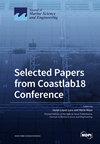Hydrodynamic Analysis of Different Formation Configurations of Catamaran in Regular Head Waves
IF 2.8
3区 地球科学
Q1 ENGINEERING, MARINE
引用次数: 0
Abstract
When undertaking long-distance missions at sea, vessels aim to achieve an extended operational range through drag reduction and energy efficiency, while enhanced wave resilience also provides substantial benefits. In this work, the Delft-372 catamaran is utilized to investigate the feasibility of drag reduction and roll mitigation for catamaran formation sailing in waves, analyzing the effects of three different formation configurations and varying spacings. The overset grid method was employed to simulate vessel motions, while the Volume of Fluid (VOF) method captured the free surface. First, the numerical results of the catamaran’s resistance, pitch, and heave motion amplitudes under different wave conditions were compared with experimental data to verify the accuracy of the CFD numerical method, and a grid convergence analysis was performed. Next, numerical models of the Delft-372 catamaran were constructed in parallel, tandem, and lateral formations under wave conditions. The results of the single-ship simulation were employed as a benchmark to analyze the impact of different formation configurations and varying lateral and longitudinal spacings on the resistance, pitch, and heave motions of the catamarans. The study also examined the effects of wave interference between vessels and the combined influence of external waves on individual and overall hydrodynamic performance. Results indicated that the tandem formation outperformed the parallel and lateral formations, with optimal performance observed at the longitudinal distance of 1 LPP. Generally, during navigation, the follower catamaran should ideally be positioned in the trough of the stern wave of the leader catamaran.双体船在规则顶浪中不同编队配置的水动力分析
在执行远距离海上任务时,船舶的目标是通过减少阻力和提高能效来延长作业航程,同时增强抗浪能力也能带来很大益处。在这项工作中,利用 Delft-372 双体船研究了双体船编队在波浪中航行时减少阻力和减轻翻滚的可行性,分析了三种不同编队配置和不同间距的影响。采用超集网格法模拟船只运动,同时采用流体体积法(VOF)捕捉自由表面。首先,将不同波浪条件下双体船的阻力、俯仰和翻腾运动幅度的数值结果与实验数据进行了比较,以验证 CFD 数值方法的准确性,并进行了网格收敛分析。接着,构建了 Delft-372 双体船在波浪条件下的平行、串联和横向编队数值模型。以单船模拟结果为基准,分析了不同编队配置以及横向和纵向间距变化对双体船阻力、俯仰和翻腾运动的影响。研究还考察了船只之间的波浪干扰以及外部波浪对单艘船只和整体水动力性能的综合影响。结果表明,串联编队的性能优于平行和横向编队,在纵向距离为 1 LPP 时观察到最佳性能。一般来说,在航行过程中,跟随双体船最好位于领航双体船的尾波波谷中。
本文章由计算机程序翻译,如有差异,请以英文原文为准。
求助全文
约1分钟内获得全文
求助全文
来源期刊

Journal of Marine Science and Engineering
Engineering-Ocean Engineering
CiteScore
4.40
自引率
20.70%
发文量
1640
审稿时长
18.09 days
期刊介绍:
Journal of Marine Science and Engineering (JMSE; ISSN 2077-1312) is an international, peer-reviewed open access journal which provides an advanced forum for studies related to marine science and engineering. It publishes reviews, research papers and communications. Our aim is to encourage scientists to publish their experimental and theoretical results in as much detail as possible. There is no restriction on the length of the papers. The full experimental details must be provided so that the results can be reproduced. Electronic files and software regarding the full details of the calculation or experimental procedure, if unable to be published in a normal way, can be deposited as supplementary electronic material.
 求助内容:
求助内容: 应助结果提醒方式:
应助结果提醒方式:


